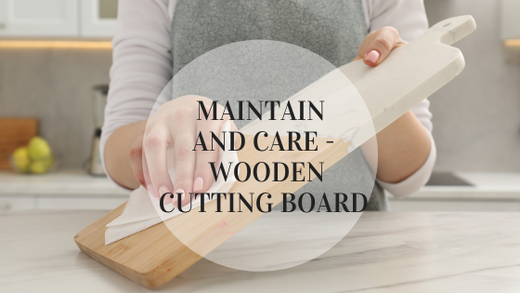A wooden cutting board is a kitchen essential that combines beauty and functionality. Whether you're using it for chopping vegetables, slicing meats, or prepping your next meal, caring for your wooden board is key to ensuring its longevity and maintaining hygiene. In this blog post, we’ll provide step-by-step instructions on how to properly clean, sanitize, and oil your wooden cutting board, ensuring it remains in excellent condition for years to come.
Why Wooden Cutting Boards Need Care
Wooden cutting boards are not just aesthetically pleasing; they are also gentle on your knives, helping them stay sharp longer. However, without proper maintenance, a wooden board can absorb moisture, develop cracks, or become a breeding ground for bacteria. With the right cleaning and care routine, you can ensure that your wooden cutting board continues to serve you well, especially during meal prep.
Step-by-Step Instructions on How to Clean and Maintain Your Wooden Cutting Board
1. Cleaning the Cutting Board After Each Use
Proper cleaning is crucial to keeping your wooden cutting board safe and hygienic, especially when it’s used for meal prep with raw ingredients.
- Wipe Immediately: After you finish using the cutting board, wipe or gently rinse it with warm water to remove food debris.
- Avoid Soaking: Never soak your wooden board in water, as prolonged exposure to moisture can cause it to warp or crack.
- Use a Gentle Scrub: Use a soft sponge or brush to scrub the surface. Avoid abrasive scrubbers as they can scratch the wood.
- Dish Soap: Apply a small amount of mild dish soap to the sponge and clean the board. Be sure to rinse thoroughly.
2. Sanitize Your Cutting Board
Wood is naturally antimicrobial, but it’s still important to sanitize your cutting board regularly, especially after cutting raw meat or seafood.
- Vinegar Solution: You can sanitize your board with a mixture of 1 part white vinegar and 4 parts water. Spray the solution over the board, let it sit for a few minutes, then rinse and wipe it dry with a clean towel.
- Hydrogen Peroxide: For extra sanitization, you can use 3% hydrogen peroxide. Pour it on the surface and let it sit for a few minutes before rinsing.
- Avoid Harsh Chemicals: Never use bleach or strong chemicals on your wooden board, as they can damage the wood and leave harmful residues.
3. Remove Stubborn Odors and Stains
Sometimes, wooden cutting boards absorb strong odors from garlic, onions, or fish. To eliminate these odors and stains:
- Baking Soda Paste: Make a paste with baking soda and water. Apply it to the stained areas and scrub gently with a sponge. Rinse off thoroughly.
- Lemon: For freshening up the board, cut a lemon in half and rub it over the surface. The acid in the lemon helps neutralize odors.
4. Oiling Your Wooden Cutting Board
Oiling your wooden cutting board is essential to maintaining its integrity and preventing cracking or drying out. Here's how to do it properly:
- Choose the Right Oil: Only use food-safe mineral oil, beeswax, or specially formulated cutting board oil. Avoid vegetable oils, as they can go rancid over time.
- Apply Oil Generously: Pour a small amount of oil onto the surface of the board. Use a soft cloth or paper towel to rub the oil into the wood, following the grain of the wood.
- Allow Absorption: Let the oil soak into the board for at least 30 minutes to an hour. Wipe off any excess oil with a clean cloth.
- Regular Maintenance: Oil your cutting board every 2-3 weeks, or more often if you use it frequently for meal prep. The more often you oil it, the longer your board will stay in great shape.
5. Store Your Wooden Cutting Board Properly
Proper storage is key to ensuring the longevity of your wooden cutting board. Here are a few tips for storage:
- Keep it Dry: Store your cutting board in a dry, well-ventilated area. Avoid leaving it in humid places like next to the sink or dishwasher.
- Avoid Direct Sunlight: Don’t store your board in direct sunlight as this can cause the wood to dry out and crack.
- Positioning: Place your cutting board flat when storing it. This helps maintain its shape and prevent warping.
Additional Tips for Prolonging the Life of Your Wooden Cutting Board
- Avoid Extreme Temperatures: Never place your wooden cutting board in the dishwasher or microwave. High temperatures can damage the wood.
- Rotate Your Board: If your board has two usable sides, rotate between the two to avoid uneven wear.
- Treat with Beeswax: If your board is heavily used, consider applying a beeswax and oil mixture for extra protection against moisture.
Conclusion
By following these simple steps for cleaning, sanitizing, and oiling your wooden cutting board, you’ll ensure that it stays functional, hygienic, and beautiful for many years to come. Whether you're preparing meals for the week or slicing your favorite fruits and vegetables for dinner, taking care of your wooden cutting board is essential for both hygiene and longevity. Regular maintenance not only keeps your board in good shape but also ensures that every meal prep session goes smoothly!

